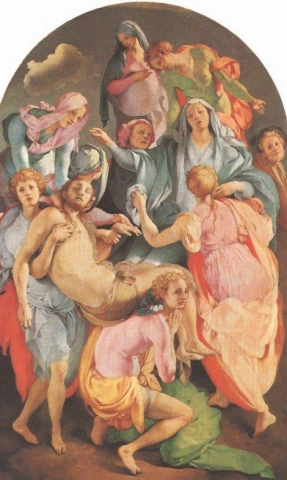

Hand painted reproductions of Jacopo da Pontormo
Jacopo da Pontormo: A Master of the Mannerist Style
Jacopo da Pontormo (1494–1557) was an Italian painter renowned for his innovative work during the Renaissance and early Mannerist period. Known for his expressive use of color, dynamic compositions, and elongated figures, Pontormo became one of the leading figures in the Mannerist movement. His works reflect the evolving artistic sensibilities of the 16th century, as well as his distinct approach to religious and portrait painting.
Early Life and Education
Jacopo da Pontormo was born in Pontormo, a small town near Florence, in 1494. He was introduced to the world of art at a young age and began his formal education under the guidance of the renowned Florentine painter Leonardo da Vinci’s follower, Andrea del Sarto. Pontormo’s early training under del Sarto exposed him to the rich traditions of the High Renaissance, which would later influence his own unique style.
After studying with del Sarto, Pontormo also spent time in the workshop of the influential Florentine artist Piero di Cosimo. His exposure to both Renaissance and early Mannerist ideas helped shape his approach to art, leading him to develop a distinct visual language that bridged the classical tradition with the innovative spirit of the Mannerist style.
Artistic Development and Style
Pontormo’s artistic style is often associated with Mannerism, a movement that emerged after the High Renaissance and was characterized by a departure from the balanced harmony of the earlier period. Mannerist artists like Pontormo experimented with exaggerated proportions, distorted perspectives, and unconventional color palettes, which set their work apart from the more naturalistic style of the Renaissance.
One of Pontormo’s signature techniques was the elongation of figures, which created an elegant and otherworldly appearance. His use of vibrant, often non-naturalistic colors, such as vivid blues, pinks, and greens, further emphasized the emotional intensity of his compositions. The poses of his figures are dynamic and often contorted, imbuing his works with a sense of movement and psychological depth.
Pontormo’s work also displays a deep understanding of light and shadow, which he used to create a heightened sense of drama. His paintings, such as The Deposition (1528), reflect his unique ability to convey religious narratives through complex, emotional compositions that focused on individual expressions and intimate moments.
Themes and Significance
Pontormo’s paintings were often centered around religious subjects, particularly Biblical stories. However, his approach to these themes was highly individualized and emotive, diverging from the more serene and balanced depictions seen in earlier Renaissance art.
One of Pontormo’s most famous works, The Deposition (1528), illustrates the dramatic moment when Christ is taken down from the cross. The figures in the painting are exaggerated in their poses, with limbs extended and bodies twisted in unnatural ways, heightening the emotional tension of the scene. This emotional intensity is a hallmark of Pontormo’s work, as he sought to explore the psychological and spiritual aspects of his subjects.
Pontormo also created several portrait works, most notably his Portrait of a Young Man in a Red Cap (1517). In these portraits, he was able to convey not only the physical likeness of his sitters but also their inner emotional state, an ability that would influence later portrait artists.
Pontormo's work was significant in that it challenged the ideals of classical harmony and proportion that had dominated Renaissance art, offering a new, more complex interpretation of form, color, and emotion. His style anticipated the developments of Baroque art, particularly in the use of dramatic lighting and expressive compositions.
Achievements and Influence
Pontormo was highly regarded in his time and worked on several important commissions for churches and private patrons in Florence and beyond. His frescoes in the Certosa di Galluzzo, as well as his work on the Visitation fresco in the Church of San Michele, are considered masterpieces of Mannerist art.
Pontormo’s work was influential to other artists of the time, particularly those working within the Mannerist tradition. His use of color and form had a profound impact on later artists such as El Greco, who was known for his dramatic use of color and elongated figures. His work also influenced the development of Baroque art, particularly in the emotional intensity and dramatic compositions that would become characteristic of the Baroque style.
Legacy
Jacopo da Pontormo’s legacy as a master of the Mannerist style is still celebrated today. His innovative approach to composition, color, and emotional depth made him a key figure in the transition from the High Renaissance to the Baroque period. His works continue to inspire and influence artists around the world.
Pontormo’s art is held in major collections, including the Uffizi Gallery in Florence and the National Gallery in London. His contributions to the evolution of Western art ensure that he remains a pivotal figure in art history.
Where to Find Reproductions of Jacopo da Pontormo’s Art
Reproductions of Jacopo da Pontormo’s emotionally charged and dramatically composed paintings are available through POD (Painting On Demand). Our high-quality handmade oil paintings on canvas allow you to bring the grandeur and intensity of Pontormo’s Mannerist masterpieces into your home or collection.
Imagine owning an original work of art by Jacopo da Pontormo, one of the greatest artists in history. At POD we offer you the opportunity to make this dream come true. We reproduce Jacopo da Pontormo's works down to the smallest detail, so you can enjoy them in your own home.
Our reproductions are made by experienced artists who use the best materials and techniques. We are dedicated to providing you with the highest quality works of art, which will bring joy and inspiration to your family for generations.




